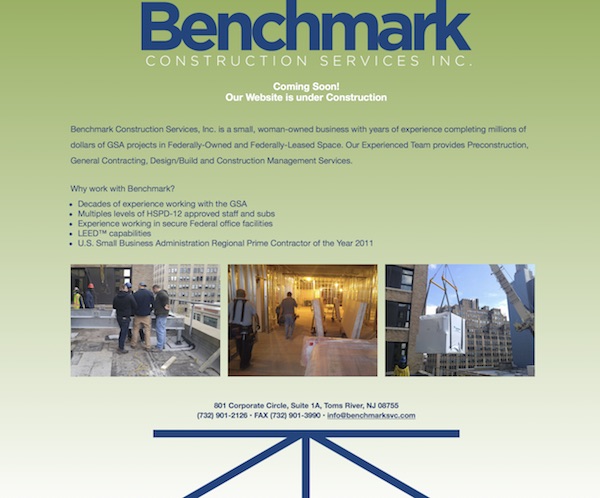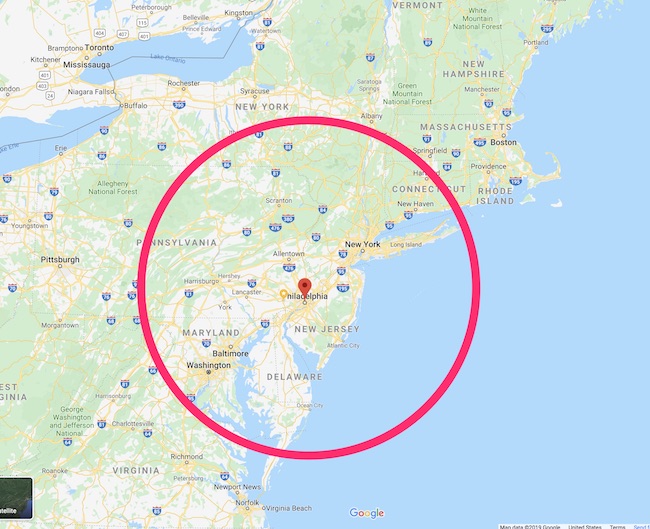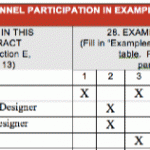
I recently met someone desperately trying to grow their Disadvantaged Business Enterprise (DBE) engineering firm. But they were going about it in a way I thought was a bit crazy.
So, what I’m going to do today is provide a complete, soup to nuts, guide on how to grow your DBE firm the smart way.
In this post, I’m going to outline exactly how I would approach growing a DBE firm (which would include WBE, MBE, and 8A firms). For the sake of ease (and my sanity), I’m going to use the term DBE throughout.
I’ll try my best to give you a step-by-step approach while explaining the whys along the way.
Although some of my advice could apply to all firms, much of it is going to address the unique position DBE firms find themselves in.
What A DBE Shouldn’t Do
The guy I was talking to wanted to submit a proposal on a contract. I’m all about submitting proposals. But the more I spoke to this guy, the more my “spidey senses” tingled.
You see:
- It was a recompete for a contract that had an incumbent who could meet the set-aside requirement.
- They didn’t have the required experience.
- They didn’t have the right people to staff the job.
- They couldn’t find a teaming partner.
- They weren’t comfortable writing the technical approach.
- They weren’t comfortable pricing the contract.
- Their intelligence identified that the client was happy with the incumbent.
- The proposal was due within a few short weeks.
You can imagine my response to these circumstances. There wasn’t a clear road to winning the contract for this particular firm.
“But I want to grow my business,” was his response.
I get that but I explained that proposals cost money and there was a better way to invest money into growing a DBE firm.
What Is DBE?
In short, a DBE is a for-profit small business where socially and economically disadvantaged individuals own at least a 51% interest and also control management and daily business operations.
If you’re unfamiliar with DBEs, you’ll likely have a lot of questions like:
- What qualifies as a disadvantaged business?
- Who qualifies for DBE?
- How do I get DBE certified?
There is a very detailed description over at transportation.gov. And if you are unfamiliar with the term, I advise you to read through that webpage.
But it is important to understand that the concept of DBEs is not just related to transportation projects. The concept applies to nearly every aspect of what government agencies buy (probably most prevalently in the construction industry).
In fact, I even know a cupcake bakery that is registered as a DBE. And you can register your firm as a DBE with the Federal Government using the instructions at this link. And the US Small Business Administration has a nice little list of where you can register as a DBE for each state.
If you do decide to seek DBE certification, make sure you ask the agency if they have a DBE certification checklist.
What Is The Difference Between A DBE and MBE?
Different agencies have different regulations regarding DBEs. Therefore, you may see different acronyms used like Minority Business Enterprise (MBE), Small Woman-Owned Business Enterprise (WBE), or Historically Underutilized Business (HUB). All of these entities might fall within an agency’s DBE program.
But each of these acronyms might mean slightly different things at different agencies. Don’t assume that your MBE firm is considered a DBE with every agency.
The Unique Position DBE Firms Are Put In
DBE firms are put into a unique position that is both good and bad.
The Good
Public agencies often have goals they must to meet regarding DBE participation. In many cases, it is painful for them if they miss these goals. And many often struggle with meeting their goals. There are just not enough good DBE firms out there.
Large firms (often referred to as primes) with gigantic government contracts can also struggle with meeting their goals. Here’s why. Let’s say a large firm has a $100M contract with a 20% DBE participation goal. That means they have to pay $20M dollars to DBE firms to perform useful services on the contract.
But there are two catches. First, a DBE firm’s services might be cheaper than the prime’s. 20% of the contract value might translate into 30% or 40% of the work. Second, it’s difficult to use just one firm in this situation. Receiving $20M might result in the DBE firm “growing out” of the program. Additionally, the DBE firm might struggle with providing the staff needed (especially if the economy is thriving).
Public DBE databases are practically useless when it comes to finding the right DBE partners. It is very hard to get a real sense of a firm from a database listing. And anybody registered as a DBE can say whatever they want in these databases. So, often primes rely on word of mouth.
The bottom line here is that DBE firms are in high demand. And once you get a foot in the door and can deliver the goods, you’re in a good position.
The Bad
For whatever reason, DBE firms have a reputation. It may be warranted. It might not be.
Let me explain.
You’ll see many DBE firms listed on an agency’s website. But when you dig deeper, you’ll often learn that very few DBE firms actually work with the agency.
The “common wisdom” is that good DBE firms are hard to find. Once you find one, use them as much as possible. This makes it a little tough for new, unproven, DBE firms to break into new agencies or teaming situations.
Another problem is that DBEs often have to subcontract with larger firms. That puts you further down the payment chain. In addition, many “primes” see DBE firms as a commodity (or necessary evil), so they won’t hesitate to ask a DBE to “sharpen their pencil.”
And last, but not least, some might argue that the point of the DBE program is to grow out of the DBE program. But a large majority of DBE firms never grow out of the program. In a sense, the DBE program might be a challenge if you want to grow into a large firm.
How To Grow Your DBE Firm
To grow your DBE firm, we’re going to flip the script. And by that, I mean you’re not going to settle for being the “typical” DBE firm. You’re going to be a different type of DBE firm, one that some large firms won’t even recognize.
I call this the “To Good To Be True” DBE. Before you get your feathers in a ruffle with that name, it will become much clearer as you read on.
Becoming “Too Good To Be True”
We’re going to flip the stereotypes on their head and use them to our advantage. And to do this, we’re going to utilize “D.O.T.S.”
Design
Outreach
Training
Systems And Administration
A good rule of thumb to start is to invest evenly in all of these things. So, if you’re a very small firm and only have $1,000 to invest in growing your business…the breakdown would look like this:
Design: $250
Outreach: $250
Training: $250
Systems and Administration: $250
Frankly, if you don’t have $1,000 to invest in your business…you shouldn’t be in business.
If you had $20,000 to invest, it would look more like:
Design: $5,000
Outreach: $5,000
Training: $5,000
Systems and Administration: $5,000
With a $1,000 investment, you can get some traction. But with a $20,000 investment, you’ll get even more.
Step One: Design
The common perception is that DBE firms are “lesser firms.” They are not as good or as polished as big firms. Let’s use that negative stereotype to actually help set us apart.
During our outreach, we want to provide promotional materials that are as impressive as the biggest firms out there. If you’re just starting out, it might be an extremely well-polished resume and a single sheet describing your firm.
Regardless, everything you hand to a potential client must scream, “This firm has it together!”
That means professional design with professional headshots.
Pick just one or two promotional items to have professionally designed. Get rid of anything else that doesn’t represent you as “the most sophisticated firm in the country.”
See: How To Get Good Design For Cheap
See: 70+ Modern Corporate Brochure Templates
If you have a website that looks like garbage. Take it down and replace it with a simple (but professional looking) “coming soon” page.

You’ll see an example of a simple “coming soon” page that I would find acceptable above.
As you grow, you’ll be able to afford the impressive, well-designed, website. But right now, focus on getting a few promotional documents that make you look “top notch.”
See: How I Built A Great A/E/C Corporate Website For Under $7,000
We’ll use the one or two promotional documents I mentioned for our outreach. And for reasons you’ll learn soon enough, they may be a whole new round of design you need after you do your outreach.
Step Two: Outreach
The “common wisdom” is that you find people to buy your services. As much as we all love to hear people hock their services to us, this is another place where we’re going to flip the script.
Remember, I explained that agencies have to meet their DBE utilization goals. These are often agency-wide goals. And these agencies have no control over the makeup of the DBE industry around them. Therefore, they may have too many DBE firms that provide Service A, but not nearly enough that provide Service B.
So, what we’re going to do is talk to potential clients and find out which areas of service they’d like to use DBE firms for. We’re also going to find out the prime firms they like to work with so we can contact them.
Instead of selling these potential clients on our great firm and our great services, we’re going to focus on identifying and fulfilling their needs. If they need the services we already provide, that’s great. But we’re not going to limit ourselves and we’re going to focus on their needs, not our offerings.
Wait A Minute!
“But wait a minute Matt, I’m a bridge designer!”
Well, if you own a DBE firm, I can assure you that you aren’t a bridge designer. No. You are the CEO of a company. And successful companies provide services that clients need.
Let me give you an example. One of the most successful DBE engineering firms in Boston got their start making photocopies. As they grew, they became choosier about what they took and found their niche.
Sure, if all your experience is on bridges, you’ll have to initially work on assignments that relate to your past experience. If all you’ve ever done is design bridges, you’ll be hard-pressed to get on a contract designing airport runways.
But to grow your firm (at least initially), everything that you have experience doing has to be on the table. It’s about what you and your staff have done. It’s not about what you “can do.”
You’ve got to prove yourself before anyone in their right mind would hire you to do something you have no resume for.
Who To Reach Out To
What we’re going to do is identify agencies we’d like to work with. Get a map and draw a circle that encompasses a four-hour drive from your location. If your service is managing construction, limit it to one-and-a-half to two hours to start.

The image above circles an area within four hours reach of Philadelphia. You’ll notice there are six different states in that area.
Identify the agencies you want to work with that are located within that circle. Your mission is to meet with people who work in those agencies who might buy services.
I would aim for people with “assistant,” “deputy,” or “district” in their title. Those are usually decision-makers who are easier to get meetings with. For example, you might target a “District Engineer” or the “Assistant Director of Design and Construction.”
How To Get Meetings
I’ve covered how to get meetings in my “guide to getting meetings.” You can use the approach I describe there.
But here’s your hook: “You want to learn about their challenges, where gaps in their DBE needs might be, and how you can help them achieve both their DBE and program goals.”
Remember, your goal is to learn what they need. So, make sure you bring a notebook and write down what they say.
A side goal is to learn which “primes” they like to work with and the name of someone at that firm you might contact. Again, write all this stuff down.
In addition, make sure you attend any DBE outreach event that the agency might have. Those are fantastic opportunities to meet potential teaming partners and use the tactics I outline in my guide to getting meetings.
Reaching Out To Primes
You’ll also use the approach from my guide when reaching out to primes. Just use the contact information that has been provided to you by the agency. And make sure you mention the name of the person you received the name from when you reach out.
Don’t Be Afraid To Reach Out To Team
If you come across an unexpected request for proposal that you think your firm can add value to, don’t be afraid to reach out to primes who win contracts with that agency.
Feel free to send interested parties an email that describes:
- How you got their name.
- Who you are (including your certifications).
- What scope you think you can knock out of the park.
- Any advantages they would have by adding you to their team.
Never assume that a prime, even after you’ve met with them, will remember to put you on their team. And don’t assume that because they didn’t reach out to you it means they don’t want you on their team.
It’s your obligation to reach out to them to get on their proposals, every time.
Step Three: Training
I’m sure the services your DBE firm provides are amazing. I’m sure your work product is impeccable.
But here’s the thing. If I was to ask large firms about their biggest gripe with DBE firms, nine times out of ten they’ll say it’s the quality of work they do.
So, we have to completely flip this script. Heavy investment into improving your skills and the skills of your staff is critical.
The goal isn’t to be the best DBE firm for what you do. It is to be the absolute best firm at what you do…period. That means you need to invest in yourself and your people.
Further, you need to train your staff (or hire people) with the skills needed to provide the services your clients need. Once you have a foot in the door and have proved you have quality assurance systems in place, it will be easier for you to get on teams for new service lines.
Step Four: Systems and Administration
This is where we solidify our position as the “Too Good To Be True” DBE. What we need to do is implement systems that eliminate any potential gripe a client might have about you.
In some cases, this will mean you need the help of people (internal or consultant) to set up systems within your firm. You may even need someone to help make sure these systems are not only working but being followed precisely and consistently.
Repeat after me…SYSTEMS WILL MAKE OR BREAK YOUR FIRM.
Your whole team will need to follow clear and effective policies/procedures to:
- Respond quickly with tailored materials for the prime’s proposal.
- Work with your teaming partner to set clear expectations on your scope and what they expect from your work product.
- Consistently communicate work progress and hurdles with your teaming partner.
- Manage your scope and not surprise your teaming partner with change orders.
- Vet your work product before handing it off (QA/QC).
- Submit the invoices exactly when and how clients need so it is easy for them to pay you.
- Follow up on outstanding payments.
- Survey your clients’ perceptions so you can constantly refine and improve.
- Hire the right people (you’ll need to staff up as you grow).
- Capture information about what you’ve done on projects into a database.
- Ask for, track, and file letters of recommendation from clients.
If you want to learn about how to document your processes and procedures, check out the book Work The System.
Conclusion
There’s a lot of great advice for growing a business out there. But like I mentioned, DBE firms are unique entities.
But you need to utilize the inherent advantages to your DBE status while flipping the script on the disadvantages. Essentially, your mission is to become the “Too Good To Be True” option.
You do that by using design, outreach, training, and systems (D.O.T.S.).
What’s Your Advice For DBE Firms?
I’d love to hear your experience with DBE firms. What advice would you give them?
Please share your thoughts in the comments.





Speak Your Mind